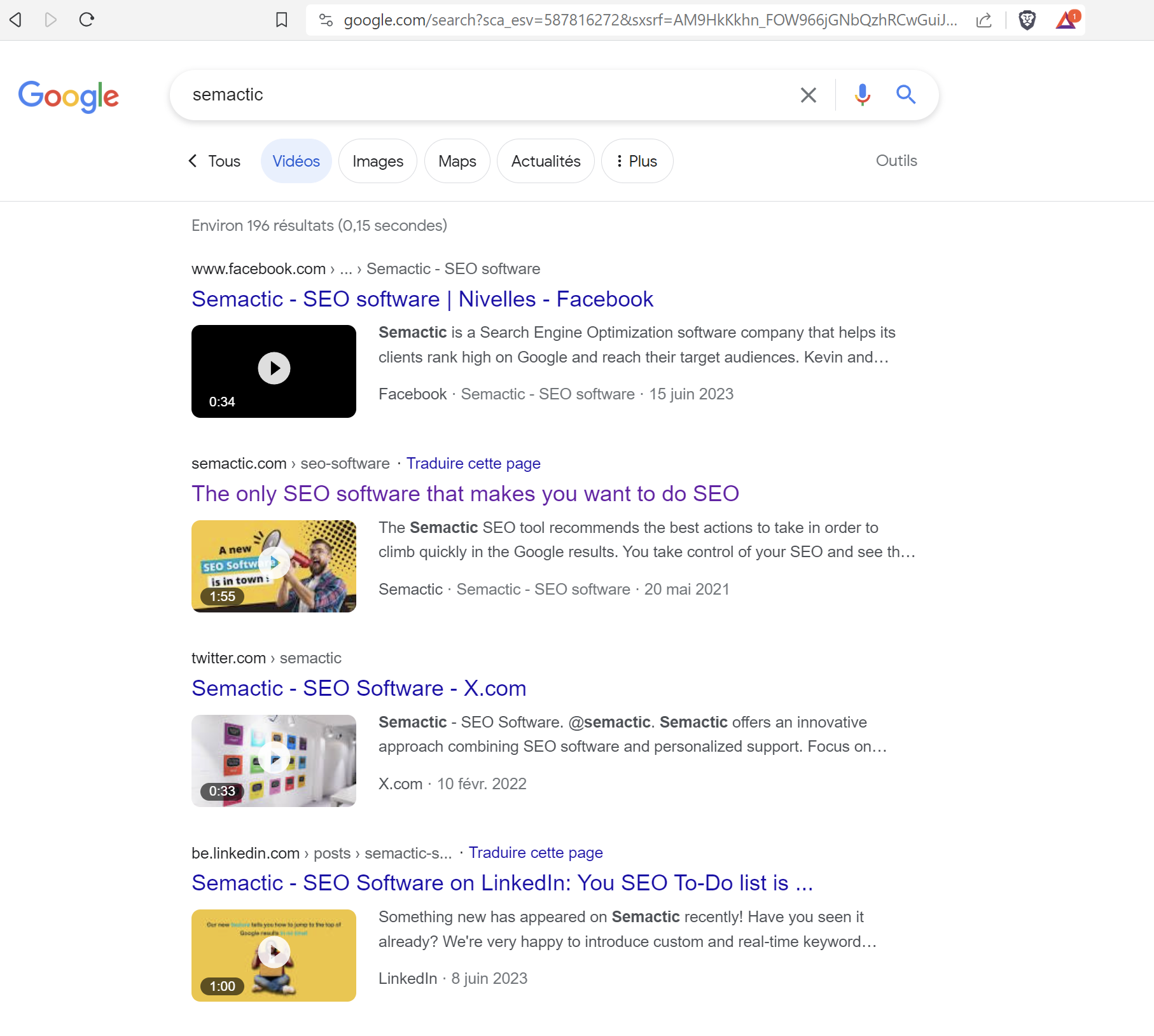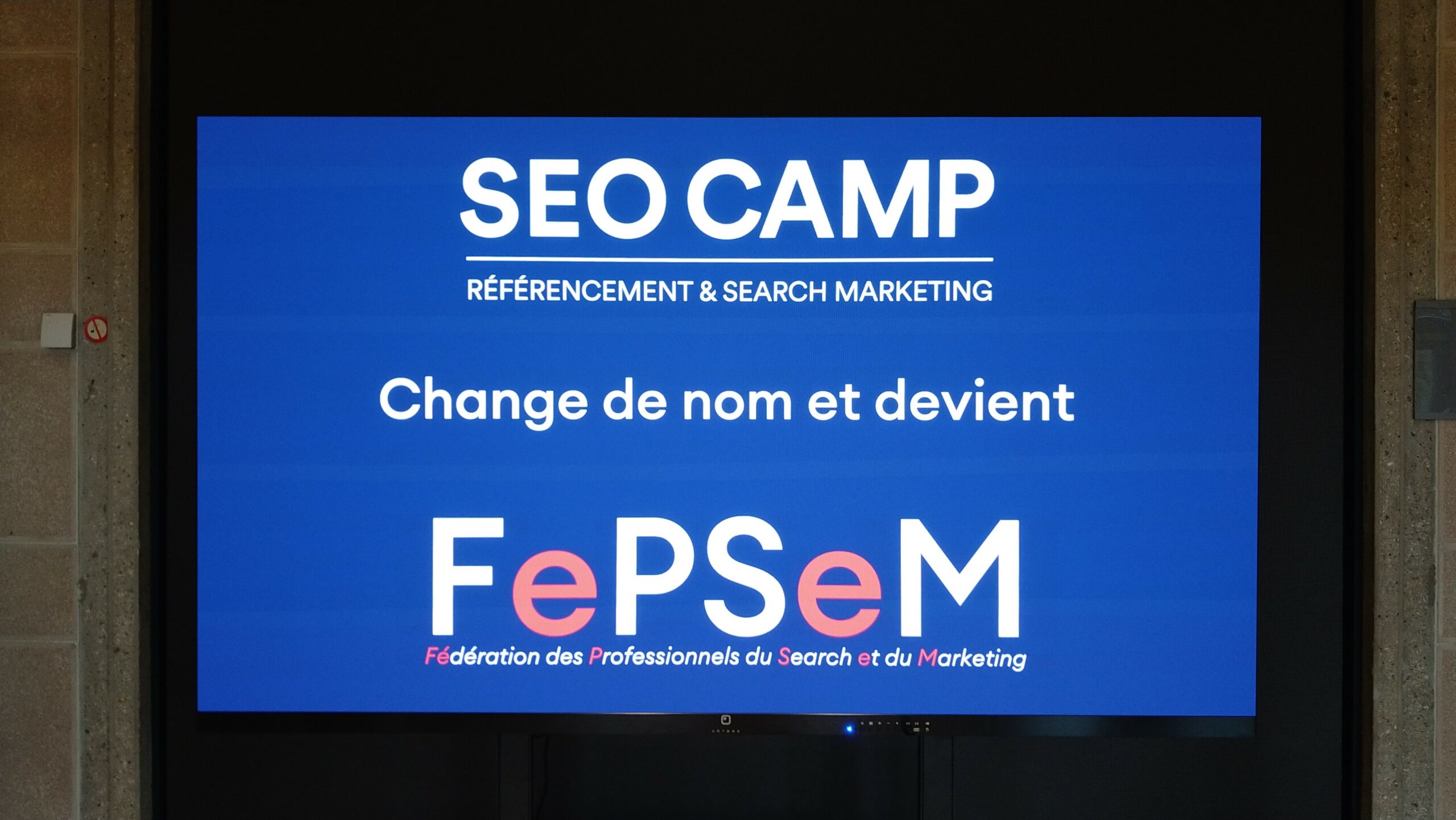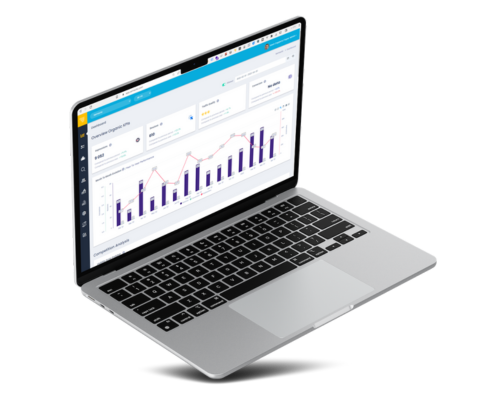A desire to exchange after 2 years of Covid, a prestigious place – the Palais des congrès de Versailles – only that – , and (almost) all the rock stars of French SEO: it was the promising cocktail of this 14th edition of the SEO Camp Paris which was held on September 22 and 23 2022. The team Semactic was there, super motivated by the desire to take advantage of the latest SEO trends: Google update, automated content, Google Discover, mesh….This is the summary of the conferences that made the biggest impression on us.
Google Discover, press and “poussaclic”
Google Discover is a new feature that offers users a selection of personalized information related to their interests when they open the Google application. This feature, 100% mobile, offers short contents that will be increasingly adapted to the user according to his searches and tastes.
In short, the user no longer needs to do a search: Google offers him results directly.
In the future, Google Discover could also offer shopping suggestions.
You will have understood: from an SEO point of view, these advanced contents represent a new playground to increase its visibility and its traffic in a consistent way.
In his conference, Clément Pessaux (@labisse – Digimood) revealed how to make a place for yourself in these personalized content flows:
We no longer speak of SEO, but of “predictive interest”.
- A site must be fast and efficient; this is a prerequisite, not a booster
- Think first of all of the persona you are targeting when you write: you must respond to their interest
- Offer rich content: structure, videos, social networks,…
- Your content must generate a lot of traffic. This is where we come to the “poussaclic”. Because yes, you have to make people want to click, but not necessarily with dubious subjects. Again, it all depends on your audience. Think like them (not like you) and ask yourself what will capture their attention.
- The timing and the tyrhme of publication are also very important: it It is better to publish early, and at regular intervals, than to publish all your content at once. Think of publishing during breaks (half-time of the soccer game for example)
- In the same vein, the publication schedule should be defined in advance: who is watching, and at what time?
- But above all, your content must generate ENGAGEMENT: this is how Google subscribes to topics and publications



We now have all the keys in hand to perform on Google Discover… But how do we appear there?
- First point that may seem obvious, a news site will appear more easily on Google Discover. However, as Marie-David Tihon of IPM Group (@mad_tihon) explains in her own conference on SEO in the press, it is necessary to educate and train journalists on SEO and its challenges;
- Rely on subscriptions and RSS feeds to boost article sharing and virality
- Think in terms of clicks by opting for shorter titles
- Opt for an original writing angle
The success of the business depends on the target audience: you will find it easier to get a place on the platform by writing on niche topics than on highly competitive people topics.
In summary, to appear on Google Discover and succeed in performing there, you’ll need patience, a good editorial strategy, perfect technique, an engaged audience and virality.
Useful content: the Internet user at the center
How to create useful content? That’s the question many content creators are (or should be) asking themselves. Marc Turkesteen from Develink gave us the answers in his conference “Useful content, instructions for use”.
For content to be useful, its objective must be defined so that it is presented in the right format to the Internet user: does it meet a navigational, commercial or transactional research intention?
- A navigational search intent means that the user is looking for a specific web page: he knows exactly what he wants. It is important to be well referenced on your own brand name so that they find you
- A commercial search intent means that the Internet user wants to make a purchase, but does not know where. In this case, you need to create content that combines SEO and conversion with an optimized customer journey. The content can be a product sheet, a comparative article, a case study, etc.
- A transactional search intent means that the user is close to purchasing and has a clear idea of what they are looking for. The objective here is obviously to facilitate acquisition and increase the average basket. The content must make people buy: detailed product sheets, attractive shopping cart page, reassurance elements, etc.
Understanding the difference between these three types of search is crucial in SEO. Our advice: start with your SEO persona to identify their interests and the triggers that encourage them to consume content.
Once the type of search intent has been identified, the content must be structured. Whether you write yourself or use an external writer, there are several techniques for writing articles:
- The QQOQCP method consists in building its content around the following questions: What – Who – Where – When – How – Why
- The AIDA method consists in making the reader go through four phases during his reading: attention, interest, desire, action.
In any case, a page must be pleasant to look at, must load quickly and must be based on a single keyword. In short, one page = one intention = one keyword!



When it comes to a product sheet, the use of structured data, tag optimization and the presence of editorial elements are important.



Marc Turkesteen also explained the difference between advertorial and editorial content:
- Advertorial content is intended to generate traffic and conversion. But above all, it answers the question of an Internet user: its goal is not to make the Internet user buy directly;
- An advertorial aims to raise awareness and speaks directly about the brand: news, innovation, etc.
There are many tools to help you during the different steps of content creation: planning tools (Semrush, Cocolyze,…), semantic tools (Yourtext.guru, Seoquantum,…), control and monitoring tools (GSC, Kill Duplicate, Screaming Frog,…). Semactic offers a complete SEO platform to help you take the best actions to optimize the content of your website or your clients’ websites.
To conclude, the latest trends in SEO were discussed: artificial intelligence (AI) assisted writing is making its way, in the form of software such as Jasper.ai. If it can help us find inspiration, it is still advisable to check the texts it produces. AI is not yet ready to replace humans.
In her talk on how to make your content strategy take off on a small budget, Morgane Surlenet of Skribix (@MorganeSurlenet) completes the picture by emphasizing theimportance of context, purpose and target in content writing. Sometimes it’s best to “shake up” your editorial calendar habits: it’s better to detect opportunities for topics as they arise than to predict a complete list of articles in advance.
AI, enemy to fight or ally?
In recent years, AI has made tremendous progress in the field of writing. The current AI, GPT-3, allows
now
to build
quickly
content with impeccable spelling and no syntax errors
. Many editors perceive this tool with distrust: AI do will soon be added to an already long list of competitors? Baptiste Guiraud (@tistou80), creator of the Rédac Academy, explains how AI can help
on the contrary
accompany
web editors in their daily work.



L’IA must be above all perceived as an assistant
an assistant
for the writer web: you need to learn how to use it to produce quality content. The “human touch” is always necessary and irreplaceable for understand the context correctly, the customer and his targetand to add a touch of empathy and creativity.as well as to add a touch of empathy and creativity. Nevertheless, theAI represents an innovation innovation thatthat web editors will have to learn to master to develop their business.
Mastering the SEO of a Javascript site
Javascript has become standardized in recent years and its frameworks are extremely popular among developers. However, Google still struggles to index correctly Javascri
pt
sites (or even to index them at all!), which is a challenge for any SEO working on a Javascript site. The creation of
Astro
an embryonic framework supported by the Chrome’s web Framework Fund, could change the game, but it is still very little used. What to do when you have to optimize a site built in Javascript? Adrien Russo (@adrienrusso) of the Web Agency gives us some tips during his conference.



Currently, there are three main methods to render pages in Javascript:
- CSR or Client Site Rendering: the site is loaded in the browser. This method has the advantage of being interactive for the user, but also the disadvantage of making the site not very crawlable.
- SSR or Server Side Rendering: it is an “on demand” loading each time a crawler or an Internet user passes on the site. This makes the site responsive, fast and scalable, but it requires more work on the server side
- Finally, the SSG or Static Site Generator: this is a pre-loading. The site is then fast and crawlable, but interactivity is put in the background.



He There is no real ideal solution. However, Adrien Russo suggests two solutions to apply depending on the volume of the website:
- In the case of a small site: a mixture of SSG and CSR. This allows to have a static page with interactive areas: the site is interactive, fast and crawlable.
- In the case of a large site: you can either opt for full SSR, which is very heavy for the server but solves the problems of crawlability; or opt for ISR which is a mix between SSR and SSG
A desire to exchange after 2 years of Covid, a prestigious place – the Palais des congrès de Versailles – only that – , and (almost) all the rock stars of French SEO: it was the promising cocktail of this 14th edition of the SEO Camp Paris which was held on September 22 and 23 2022. The team Semactic was there, super motivated by the desire to take advantage of the latest SEO trends: Google update, automated content, Google Discover, mesh….This is the summary of the conferences that made the biggest impression on us.
Google Discover, press and “poussaclic”
Google Discover is a new feature that offers users a selection of personalized information related to their interests when they open the Google application. This feature, 100% mobile, offers short contents that will be increasingly adapted to the user according to his searches and tastes.
In short, the user no longer needs to do a search: Google offers him results directly.
In the future, Google Discover could also offer shopping suggestions.
You will have understood: from an SEO point of view, these advanced contents represent a new playground to increase its visibility and its traffic in a consistent way.
In his conference, Clément Pessaux (@labisse – Digimood) revealed how to make a place for yourself in these personalized content flows:
We no longer speak of SEO, but of “predictive interest”.
- A site must be fast and efficient; this is a prerequisite, not a booster
- Think first of all of the persona you are targeting when you write: you must respond to their interest
- Offer rich content: structure, videos, social networks,…
- Your content must generate a lot of traffic. This is where we come to the “poussaclic”. Because yes, you have to make people want to click, but not necessarily with dubious subjects. Again, it all depends on your audience. Think like them (not like you) and ask yourself what will capture their attention.
- The timing and the tyrhme of publication are also very important: it It is better to publish early, and at regular intervals, than to publish all your content at once. Think of publishing during breaks (half-time of the soccer game for example)
- In the same vein, the publication schedule should be defined in advance: who is watching, and at what time?
- But above all, your content must generate ENGAGEMENT: this is how Google subscribes to topics and publications



We now have all the keys in hand to perform on Google Discover… But how do we appear there?
- First point that may seem obvious, a news site will appear more easily on Google Discover. However, as Marie-David Tihon of IPM Group (@mad_tihon) explains in her own conference on SEO in the press, it is necessary to educate and train journalists on SEO and its challenges;
- Rely on subscriptions and RSS feeds to boost article sharing and virality
- Think in terms of clicks by opting for shorter titles
- Opt for an original writing angle
The success of the business depends on the target audience: you will find it easier to get a place on the platform by writing on niche topics than on highly competitive people topics.
In summary, to appear on Google Discover and succeed in performing there, you’ll need patience, a good editorial strategy, perfect technique, an engaged audience and virality.
Useful content: the Internet user at the center
How to create useful content? That’s the question many content creators are (or should be) asking themselves. Marc Turkesteen from Develink gave us the answers in his conference “Useful content, instructions for use”.
For content to be useful, its objective must be defined so that it is presented in the right format to the Internet user: does it meet a navigational, commercial or transactional research intention?
- A navigational search intent means that the user is looking for a specific web page: he knows exactly what he wants. It is important to be well referenced on your own brand name so that they find you
- A commercial search intent means that the Internet user wants to make a purchase, but does not know where. In this case, you need to create content that combines SEO and conversion with an optimized customer journey. The content can be a product sheet, a comparative article, a case study, etc.
- A transactional search intent means that the user is close to purchasing and has a clear idea of what they are looking for. The objective here is obviously to facilitate acquisition and increase the average basket. The content must make people buy: detailed product sheets, attractive shopping cart page, reassurance elements, etc.
Understanding the difference between these three types of search is crucial in SEO. Our advice: start with your SEO persona to identify their interests and the triggers that encourage them to consume content.
Once the type of search intent has been identified, the content must be structured. Whether you write yourself or use an external writer, there are several techniques for writing articles:
- The QQOQCP method consists in building its content around the following questions: What – Who – Where – When – How – Why
- The AIDA method consists in making the reader go through four phases during his reading: attention, interest, desire, action.
In any case, a page must be pleasant to look at, must load quickly and must be based on a single keyword. In short, one page = one intention = one keyword!



When it comes to a product sheet, the use of structured data, tag optimization and the presence of editorial elements are important.



Marc Turkesteen also explained the difference between advertorial and editorial content:
- Advertorial content is intended to generate traffic and conversion. But above all, it answers the question of an Internet user: its goal is not to make the Internet user buy directly;
- An advertorial aims to raise awareness and speaks directly about the brand: news, innovation, etc.
There are many tools to help you during the different steps of content creation: planning tools (Semrush, Cocolyze,…), semantic tools (Yourtext.guru, Seoquantum,…), control and monitoring tools (GSC, Kill Duplicate, Screaming Frog,…). Semactic offers a complete SEO platform to help you take the best actions to optimize the content of your website or your clients’ websites.
To conclude, the latest trends in SEO were discussed: artificial intelligence (AI) assisted writing is making its way, in the form of software such as Jasper.ai. If it can help us find inspiration, it is still advisable to check the texts it produces. AI is not yet ready to replace humans.
In her talk on how to make your content strategy take off on a small budget, Morgane Surlenet of Skribix (@MorganeSurlenet) completes the picture by emphasizing theimportance of context, purpose and target in content writing. Sometimes it’s best to “shake up” your editorial calendar habits: it’s better to detect opportunities for topics as they arise than to predict a complete list of articles in advance.
AI, enemy to fight or ally?
In recent years, AI has made tremendous progress in the field of writing. The current AI, GPT-3, allows
now
to build
quickly
content with impeccable spelling and no syntax errors
. Many editors perceive this tool with distrust: AI do will soon be added to an already long list of competitors? Baptiste Guiraud (@tistou80), creator of the Rédac Academy, explains how AI can help
on the contrary
accompany
web editors in their daily work.



L’IA must be above all perceived as an assistant
an assistant
for the writer web: you need to learn how to use it to produce quality content. The “human touch” is always necessary and irreplaceable for understand the context correctly, the customer and his targetand to add a touch of empathy and creativity.as well as to add a touch of empathy and creativity. Nevertheless, theAI represents an innovation innovation thatthat web editors will have to learn to master to develop their business.
Mastering the SEO of a Javascript site
Javascript has become standardized in recent years and its frameworks are extremely popular among developers. However, Google still struggles to index correctly Javascri
pt
sites (or even to index them at all!), which is a challenge for any SEO working on a Javascript site. The creation of
Astro
an embryonic framework supported by the Chrome’s web Framework Fund, could change the game, but it is still very little used. What to do when you have to optimize a site built in Javascript? Adrien Russo (@adrienrusso) of the Web Agency gives us some tips during his conference.



Currently, there are three main methods to render pages in Javascript:
- CSR or Client Site Rendering: the site is loaded in the browser. This method has the advantage of being interactive for the user, but also the disadvantage of making the site not very crawlable.
- SSR or Server Side Rendering: it is an “on demand” loading each time a crawler or an Internet user passes on the site. This makes the site responsive, fast and scalable, but it requires more work on the server side
- Finally, the SSG or Static Site Generator: this is a pre-loading. The site is then fast and crawlable, but interactivity is put in the background.



He There is no real ideal solution. However, Adrien Russo suggests two solutions to apply depending on the volume of the website:
- In the case of a small site: a mixture of SSG and CSR. This allows to have a static page with interactive areas: the site is interactive, fast and crawlable.
- In the case of a large site: you can either opt for full SSR, which is very heavy for the server but solves the problems of crawlability; or opt for ISR which is a mix between SSR and SSG
Want to discuss the latest trends in SEO? Contact the Semactic team, we are always happy to discuss SEO!











